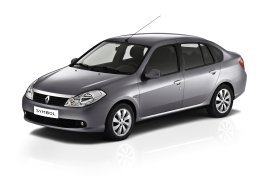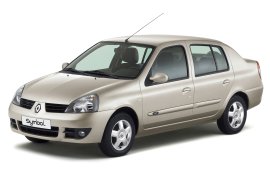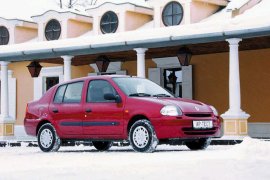RENAULT Clio Symbol / Thalia Models/Series Timeline, Specifications & Photos
First production year: 2000
Engines: Gasoline, Diesel
Renault brought the second generation of the Symbol/Thalia in 2008 for the emerging markets and improved its safety and powertrains.
Renault chose the Moscow Motor Show to unveil the second generation of the Renault Symbol, also known as Thalia, in specific countries. Unlike its predecessor, it dropped the "Clio" badge from its name and remained as a distinct range in the French manufacturer's lineup. It was entirely based on Clio's second generation and benefited from a few upgrades regarding the powertrains.
The Symbol II appeared as a composed three-box sedan and lost its bad image as a Clio with a backpack. Renault's designers worked hard to integrate the trunk into the car's general look. At the front, they installed big, swept-back headlights and a slatted grille. Up to the B-pillar, it might resemble its hatchback cousin, but from there to the back, it was different. The raked-forward D-pillar and the window behind the rear doors made a huge difference.
Inside, the designers tried and succeeded to make the interior as nice as possible for its price range. The two-tone dashboard and the scooped display for the on-board computer placed on top of the dash looked similar to those from other, more expensive, Renaults. On the plus side, Renault bragged about the 505 liters (17.8 cu-ft) trunk size, which was bigger than most of the compact-sized vehicles and definitely better than its direct competitors from the small-segment.
Renault installed more safety features on the Symbol to pass the Euro5 norms and improved the engine range, and started with the 1.2-liter, 75 hp unit. On selected markets, such as the Russian, Renault offered the Symbol with a 1.6-liter engine paired to a 5-speed manual or a 4-speed automatic.
Renault introduced a facelifted version of the Clio Symbol/Thalia in 2002, upgrading the car accordingly to the regular Clio hatchback.
In particular countries, the customers considered the three-box sedan vehicles more attractive. Renault noticed that and introduced the three-box sedan Clio Symbol, Thalia, on specific markets, based on the same platform with the regular Clio hatchback. In 2002, the French carmaker had to upgrade its lineup, and the three-box sedan also received a refresh.
At the front, the 2002 Symbol/Thalia featured the same “Bird beak” design from the rest of the Renault range. Its vertical slat divided the front grille in two and sported the chromed rhomboidal badge, and Renault extended the triangular-shaped headlights over the front plastic fenders. The Symbol featured a new body-colored bumper with a lower grille end two scoops for the optional fog lights. For the upper trim levels, it featured body-colored door handles and mirrors.
Inside, there was a similar-looking dashboard, but with increased material quality. It also featured a passenger airbag. Behind the steering wheel, Renault installed a stack that controlled the new CD stereo sound system. Another improvement was on the instrument cluster, which sported white dials and red needles for the speedometer, tachometer, and the gauges for fuel level and coolant temperature. For the upper trim levels, the carmaker offered an option for power windows.
Under the hood, Renault installed a choice of three gasoline and one turbo-diesel engine, available with a few power options, depending on the market.
Renault noticed that the new customers from Eastern European countries had an increased appeal for sedans, so it built a special version of the second-generation Clio for them, named Clio Symbol, or Thalia, depending on the country.
Soon after the fall of the Communist regimes in Eastern Europe, the customers started to ditch their former Czechoslovakian, Polish, Russian, Romanian, and East German cars for better vehicles coming from the West. One of the most important brands that benefited from that was Renault, which already had a factory in Turkey and was able to produce cheaper vehicles. Moreover, the new customers didn't like hatchbacks and station wagons, so the French carmaker did a mashup by adding a trunk to the already known Clio II introducing it to the market in 2000.
The new vehicle sported most of the front parts from its hatchback sibling, although it wasn't fitted with the best technological achievement available. Its headlights were the same, but the bumper was different and featured a smiling lower grille in the bumper. On the sides, the black trims on the doors had a different shape. Behind the rear doors, the automaker changed the C-pillar's shape and installed a redesigned rear windscreen. At the same time, the added trunk was tall and sported new taillights installed on the quarter panels, leaving a wide opening for the lid.
Inside, the carmaker installed a hard-plastic dashboard that was similar to the rest of the Clio five-door range, but it was made from less expensive materials. Moreover, the upholstery was from the bottom shelf. The front bucket seats were way better than most of the former communist carmakers, and the fixed rear bench offered just about enough room for three occupants.
Under the hood, the carmaker installed a choice of three engines, depending on the market, both gasoline, and turbo-diesel.


